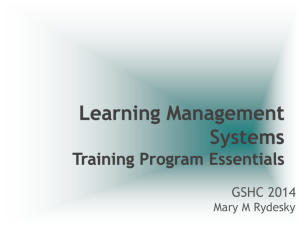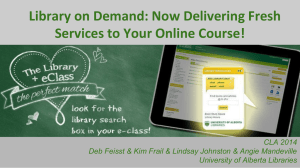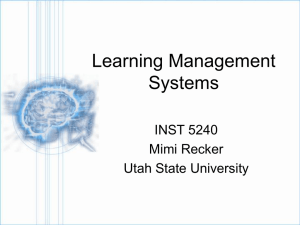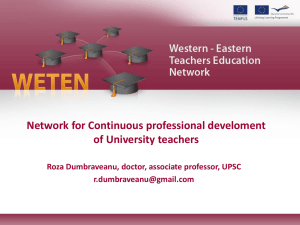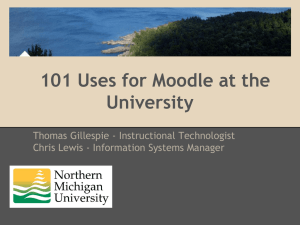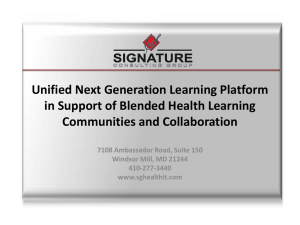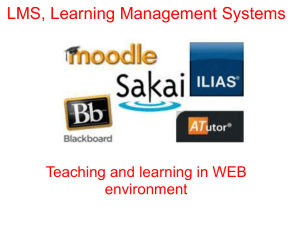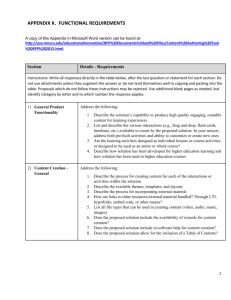LMS - Transition Management
advertisement
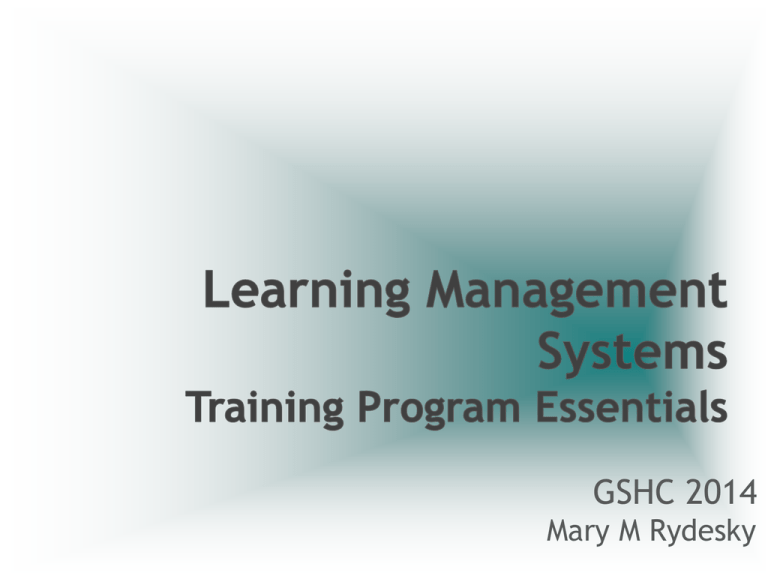
GSHC 2014 Mary M Rydesky Learning Management Systems • What really makes up an LMS? – definition of LMS – What it is not • Technology Specs • E-Learning Standards for LMSs • Demonstrations of LMSs – BlackBoard – Moodle – Others • Kirkpatrick’s Model of Evaluation LMS is…. • A learning management system (LMS) is software for automating the administration, documentation, tracking, reporting & delivery of e-learning education courses & blended training programs The LMS - the Users’ View • All LMSs have: – Library of courses – Learners – Trainers – Admins – Status reports – Ways to assign learners / trainers to a course – Ways to create a learner profile – Ways to upload & or create courses The LMS – Technical View • Database - where the data goes • Server –home of courses; runs the application • Application / programming language Produces the features & functions of the LMS – PHP, mySQL, open source • Desktop, laptop, notebook, phone – end user site – Browsers – Firefox, IE, Safari, Chrome The LMS – Trainers’ View • • • • • • Course development & revision Can blend courses from many sources Course delivery synchronous / asynchronous Social learning is supported – forums, wikis Evidence-based learning – assessment tools Engages the learner Functions & Components • An LMS is a database & repository – a software system that stores content files & tracks learner progress & provides reports • Provides access by roles – trainers – learners – others • e-Learning Standard(s) - communication bridge between the course & the database Purchase & Deployment Models Cloud-Based • Define: Not on your server Open Source Commercial • Define: On your server or cloud, non-proprietary development • Define: On your server/cloud, the software/service costs you money Choice of LMSs BlackBoard Moodle Totara Canvas Others • URL: https://wbu.blackboard.com/ • Type: Closed source • Developer: Rydesky/WBU • URL: http://dln.akdistancelearning.net/moodle/ • Type: Open source moodle.org • Developer: Rydesky - akDLN • URL: http://www.youtube.com/watch?v=anx2Oq69uOs • Type: Closed source • Lambda Software Take a Look Blackboard at Weston Pharma http://www.youtube.com/watch?v=OGZOfgN-Pfg#t=53 4:01 Canvas http://www.youtube.com/user/CanvasLMS 1:35 Moodle 2.5 http://www.youtube.com/watch?v=W4uipnBkj-4 1:14 Totara You Tube http://www.youtube.com/watch?v=anx2Oq69uOs 2:14 E-Learning LMS Technical Standards AICC SCORM 1.2 & 2004 xAPI / AICC CMI-5 Purchase & Deployment Model Pro’s Cloud-Based • Pros: Nothing to install, quick sign up, server & software maintenance not your problem Open Source • Pros: You can modify the code, no cost to download & install, unlimited site installs, backed by the community Commercial • Pros: Data is on your server, software maintenance not your problem, dedicated support staff, usually more “enterprise” than other options Purchase & Deployment Models Con’s Cloud-Based • Cons: It’s not yours, your data is in the “cloud”, you can’t update the software, high usage can generate high fees Open Source • Cons: You have to take care of it. No help desk. The cost is in IT knowledge, internal maintenance, upgrades, security patches etc Commercial • Cons: Usually start-up & yearly fees, can not make changes to the software E-Learning Standards in the LMS • Development & testing – LMS content integration has standards supported & versions, size limits, media types supported, suggested dev tools, & import/export settings – Test – different browsers & OS & devices; cloud or server based services, speed, ease of access – Test your LMS access for functional & data/comm issues • Content Delivery – Set up student account on the LMS for testing – Perform a small group test before opening courses – Check to see that all learner systems produce the same course reports in the LMS…then go live ISO 299990 Standards • Focus: on the learner & results of the process • Emphasis: the full range of options available for delivery of learning services in a global knowledge society • • • • improvement of knowledge transfer quality management organizational effectiveness sustainability through cost management User Standards • • • • • • learner satisfaction change & attainment of course objectives knowledge transfer & change measures cost (design, delivery, evaluation cycle) time efficiency value of competencies (integration of KSAs) Learner Satisfaction • Kirkpatrick Level One – Navigation ease – Technology ease – Interesting – Efficiency – Attainability of objectives Investor Satisfaction • Kirkpatrick Levels Two - Four – Knowledge transfer – Change in skills & behaviors • Effects of change brought on by learning • Phillips Level Five – Cost & impact – Sustainability ROI Management Guides • Guidelines for cost of development • Suggest time line for development • Tie development & delivery to organizational mission & objectives • Guidelines for retention of course, learner input, security & access • Guide developers, instructors, stakeholders to a shared concept of quality in eLearning via your Moodle Resources • Open Source LMS vs Commercial LMS – http://tinyurl.com/lgvoqyl • Standards – AICC www.aicc.org , http://www.syberworks.com/articles/aiccand-the-lms-article.htm – SCORM 1.2 http://www.adlnet.gov/scorm/scorm-version-1-2 – SCORM 2004 http://www.adlnet.gov/scorm/scorm-2004-4th – AICC CMI-5 http://aicccmi5.wikispaces.com/AICC+CMI5+Specification – xAPI http://www.adlnet.gov/tla/experience-api – TinCan http://tincanapi.com/ • What Standard Is Best – http://tinyurl.com/l9l4s5k • Open Source – Moodle www.moodle.org Contact Info Mary M Rydesky – Transition Management Dan Foote – DanTech Services www.transitionmanagement.us mrydesky@yahoo.com dfoote@dantechservices.com 907-227-2393 GSHC 2014
